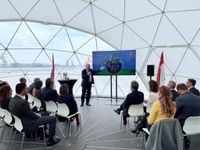In a historic move towards sustainable energy, Oman, the Netherlands, and Germany have signed a groundbreaking Joint Development Agreement (JDA) to establish the world’s first liquid hydrogen import corridor. The deal, signed during the state visit of His Majesty the Sultan of Oman to the Netherlands on April 17, 2025, aims to facilitate the large-scale import of renewable fuel of non-biological origin (RFNBO) compliant liquid hydrogen to Europe by 2029.
The agreement was inked by eleven parties, including key players such as Hydrom, Oman’s national green hydrogen orchestrator, OQ, Tata Steel Nederland, Hamburger Hafen und Logistik AG, and Hynetwork Services. This collaboration is set to unify the critical links necessary for the envisioned supply chain, leveraging proven technologies for the liquefaction, transport, storage, and distribution of liquid hydrogen.
A notable innovation in this agreement is the advanced vessel design by ECOLOG, which ensures net-zero boil-off, effectively eliminating cargo loss during marine transportation. This transformative technology promises to significantly reduce unit freight costs, setting a new standard for efficiency and sustainability in hydrogen transport.
The JDA encompasses several vital components essential for the corridor’s development. Among these is the establishment of a centralized liquefaction, storage, and export facility at the port of Duqm, a key hub for Omani-produced green hydrogen. Additionally, discussions are underway regarding the pricing and delivery of liquid hydrogen to offtakers in the Amsterdam area and other locations across the Netherlands and Germany, with EnBW acting as the aggregator.
Infrastructure development will also play a crucial role in this initiative, with dedicated facilities being constructed throughout the corridor. This includes export and import facilities in the ports of Duqm, Amsterdam, and Duisburg, as well as various distribution modalities for both gaseous and liquid hydrogen. These will encompass gas pipeline networks, rail connections, and barge distribution, capitalizing on the Netherlands' extensive canal network.
This agreement marks a significant step in Oman’s ambition to become a global leader in the green hydrogen export market while simultaneously strengthening Europe’s energy security. The initiative aligns with the European Union’s clean energy goals, contributing to the decarbonization of hard-to-abate sectors such as steelmaking and transport.
“This agreement represents a landmark moment in our commitment to clean energy,” stated Sophie Hermans, the Dutch Minister for Climate and Green Growth. “By linking Omani green hydrogen with Europe’s energy needs, we are advancing our shared climate goals and creating a sustainable energy pathway.”
Oman’s Minister of Energy and Minerals, H.E. Eng. Salim Nasser Al Aufi, echoed this sentiment, saying, “This partnership reflects Oman’s commitment to playing a leading role in the global green hydrogen economy while strengthening ties with Europe to support its sustainable clean energy transition.”
The JDA builds upon the existing collaboration between Hydrom, the Omani Ministry of Energy and Minerals, the Port of Amsterdam, ECOLOG, and EnBW for the development of the liquid hydrogen corridor. This latest development brings the project one step closer to delivering large-scale green hydrogen volumes from Oman to Europe by 2029.
However, challenges remain. A recent study by TNO indicates that the cost of producing green hydrogen in the Netherlands has exceeded expectations, with production costs now estimated at over €13 per kilogram. This raises questions about the economic viability of large-scale green hydrogen production and its competitiveness in the global market.
Despite these challenges, the agreement signifies a pivotal moment in the global energy landscape. The collaboration among Oman, the Netherlands, and Germany showcases a commitment to innovation and sustainability, paving the way for a cleaner energy future. As the world grapples with climate change, initiatives like this one are crucial in transitioning towards a more sustainable and resilient energy system.
As the hydrogen economy continues to evolve, the implications of this corridor extend beyond mere energy supply. It represents a significant shift in international cooperation, illustrating how nations can work together to meet pressing global challenges. The successful implementation of this project could serve as a model for similar initiatives worldwide, reinforcing the importance of collaboration in addressing the climate crisis.
In conclusion, the establishment of the liquid hydrogen corridor between Oman, the Netherlands, and Germany stands as a testament to the potential of international partnerships in the quest for sustainable energy solutions. With the ambitious goal of delivering green hydrogen to Europe by 2029, this agreement not only enhances energy security but also reinforces the commitment to a cleaner, greener future.





